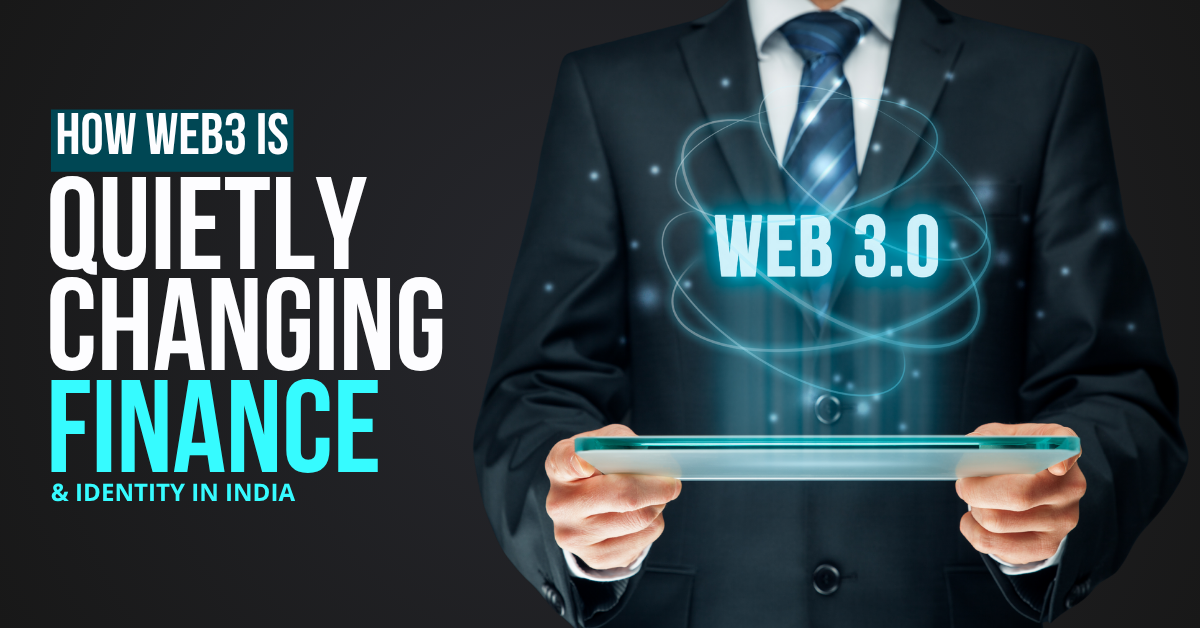Introduction: A Quiet Revolution in Motion
Web3 is not just a buzzword anymore. In India, beyond the noise of crypto crashes and global headlines, a silent transformation is underway — one that’s redefining how finance and identity are managed. From rural lending cooperatives to student credentialing, Web3 technologies are weaving their way into the foundations of India’s digital infrastructure.
This movement isn’t loud. It’s not viral on social media. But it’s real, resilient, and rapidly expanding.
What Is Web3 and Why Does It Matter to India?
Web3 refers to the next evolution of the internet, built on decentralized technologies like blockchain, smart contracts, and token-based systems. Unlike Web2, where platforms own your data, Web3 allows users to control their digital assets, identity, and interactions.
Why is this a big deal for India?
India has over 1.2 billion Aadhaar users, but limited digital ownership.
Over 190 million unbanked citizens still lack access to formal finance.
Trust in centralized platforms is declining.
Rising data privacy concerns call for self-sovereign identities (SSIs).
Web3 offers a people-first internet — and India’s scale makes it the perfect place to experiment, adapt, and lead.
1. Redefining Digital Identity Through Self-Sovereignty
In traditional systems, your digital identity is controlled by governments, banks, or platforms. But Web3 flips that model.
With Self-Sovereign Identity (SSI), Indians can create decentralized IDs (DIDs) that are verifiable, portable, and privacy-focused. These identities can store:
Education credentials
Health records
Work history
Financial scores
Property titles
Projects like Reclaim Protocol and Signzy are already piloting decentralized identity layers, allowing individuals to prove who they are without revealing everything about themselves.
Impact: This is a game-changer for gig workers, migrant laborers, and underbanked citizens — offering them a secure, reusable digital passport to access services.
2. Web3 Is Unlocking Inclusive Financial Access
Traditional finance in India is often slow, centralized, and biased. Credit scores are hard to build. Bank accounts come with red tape. And rural lending is under-penetrated.
Enter Web3.
Decentralized Finance (DeFi) platforms are enabling:
Peer-to-peer microloans without banks
Yield farming as a form of digital savings
Tokenized community lending pools
Real-time on-chain credit histories
Startups like Goldfinch, Instadapp, and Jai Kisan are exploring DeFi for Bharat, helping farmers and small businesses get capital using on-chain behavior instead of traditional collateral.
Impact: A vegetable vendor in Bihar or a weaver in Gujarat can now build a trustless, digital credit score — opening doors to capital that banks never offered.
3. Remittances & Cross-Border Transactions Are Getting Smarter
India is the world’s top remittance-receiving nation. Yet, sending money from Dubai to Delhi still takes hours, sometimes days — with fees that hurt the poor.
Web3-based remittance services are offering:
Instant settlement through stablecoins
Minimal transaction fees
Cross-border transfers without banking delays
Full transparency on money trails
Platforms like Polygon, xRamp, and Cashfree are experimenting with crypto rails for stable, legal cross-border payments — especially for Indian freelancers and overseas families.
Impact: An IT freelancer in Jaipur can now receive $500 from a client in New York instantly and convert it to INR — securely, cheaply, and without middlemen.
4. Web3 + UPI: The Future of Hybrid Payments
UPI has transformed India’s payment landscape, but it still runs on centralized rails. Imagine combining UPI’s ease with Web3’s decentralization.
Some possibilities:
Tokenized loyalty points linked to purchases
Offline crypto payments in Tier 2 towns
NFT-based payment authentication
Secure merchant settlements on blockchain
With RBI exploring the Digital Rupee (CBDC) and platforms like EtherScan India gaining traction, the merge of Web2 finance and Web3 innovation is not far.
5. Empowering Creators, Collectors, and Communities
India’s creator economy is exploding. From artists and musicians to gamers and educators — creators want ownership, not just likes.
Web3 enables:
NFTs for original content with built-in royalties
DAOs for community-led funding and decisions
Smart contracts for brand deals
Metaverse experiences driven by Indian creators
Platforms like WazirX NFT, FanCraze, and Zoth.io are opening new doors for Indian creators to earn, engage, and grow — without middlemen.
Key Sectors Where Web3 Is Creating Silent Disruption
| Sector | Web3 Impact |
|---|---|
| Identity & Credentials | Decentralized IDs, education certificates, health records |
| Agriculture & MSMEs | On-chain lending, tokenized microfinance, crop insurance |
| Cross-Border Finance | Stablecoin remittances, freelance payments |
| Creator Economy | NFT royalties, DAO funding, smart contracts |
| Payments & Commerce | Tokenized loyalty, hybrid crypto-UPI payments |
Challenges Ahead — and Why They’re Worth Solving
Web3 in India isn’t without hurdles:
Regulatory grey areas around crypto and DeFi
Limited awareness in Tier 2 and rural audiences
Technical barriers and poor UI/UX
Security risks and scams in open protocols
But none of these are unsolvable. With growing interest from Indian developers, think tanks, and fintech innovators — Web3 in India is evolving with responsibility, not recklessness.
Read
Digital Payments & Fintech Tools in India: A 2025 Market Snapshot
Conclusion: The Web3 Movement in India Has Just Begun
India’s future won’t be built by copying Silicon Valley — it will be built by adapting new tech for Indian realities. Web3 may still be in its early stages, but its potential to reshape finance, identity, and opportunity is undeniable.
What’s truly exciting? This revolution isn’t coming from big tech or government directives — it’s coming from startups in Bengaluru, students in Patna, developers in Surat, and creators in Shillong.
Web3 in India isn’t loud. But it’s here. And it’s changing everything.
Read







